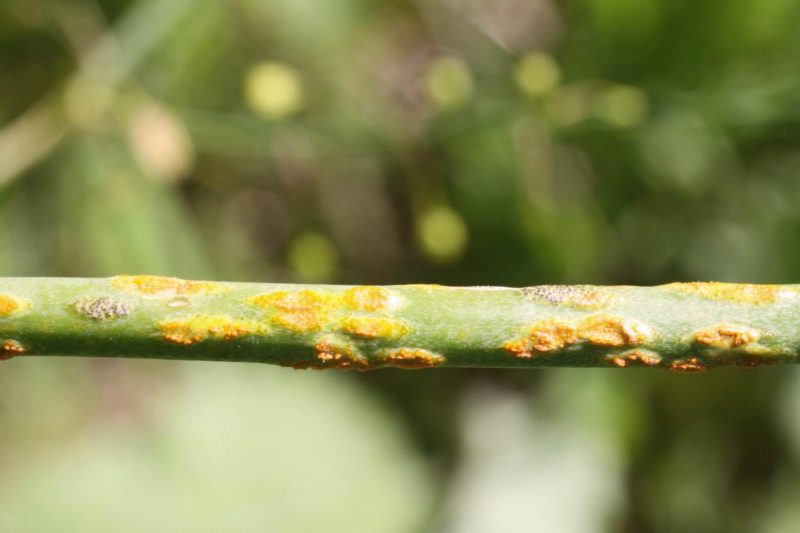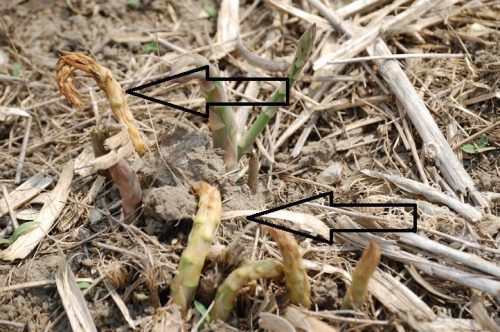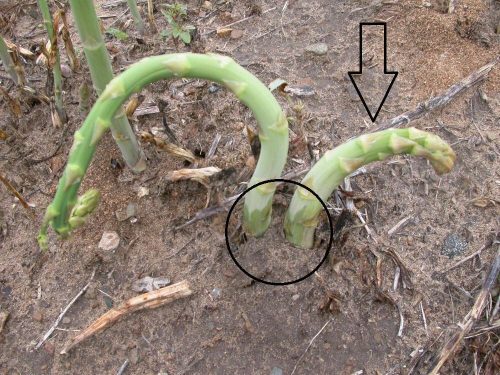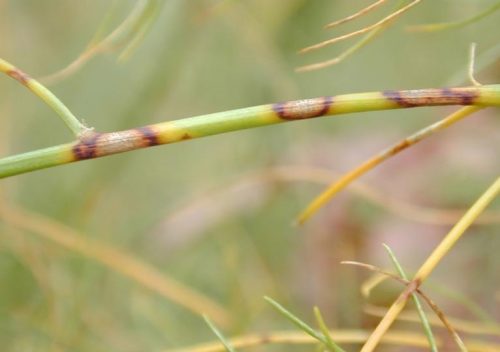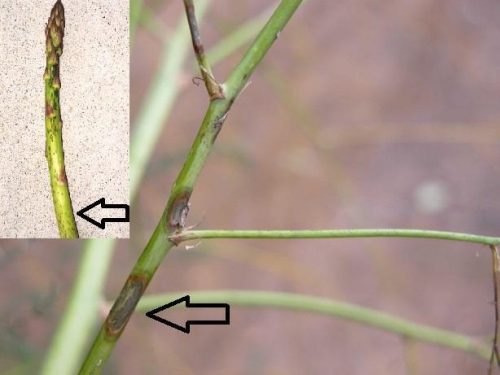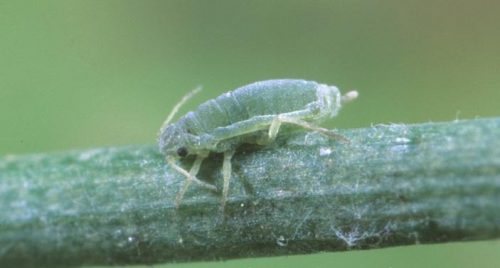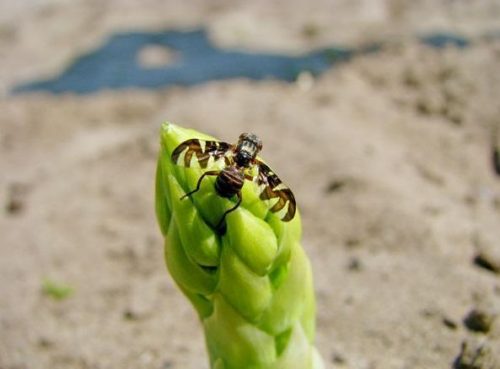Asparagus, treatments against pests and diseases
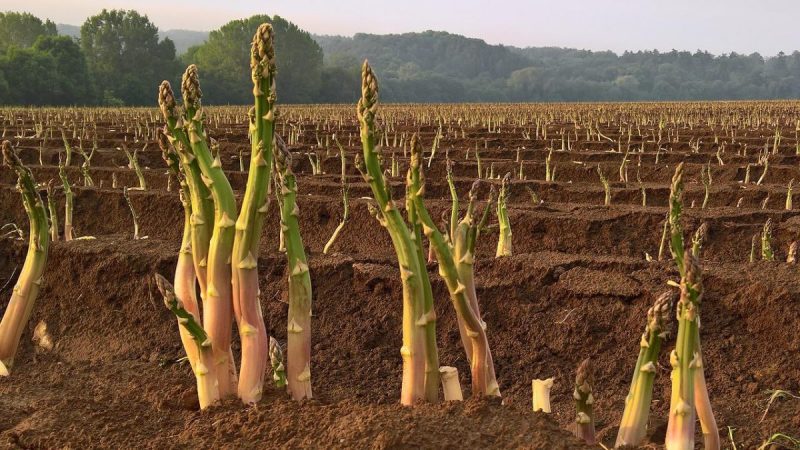
Asparagus (Asparagus officinalis) is a plant that has been cultivated since ancient Egypt for its nutrient-rich shoots. Its shoots contain vitamins (A, D, B-12), magnesium, calcium, iron, carbohydrates, and fibers. Asparagus is not an environmentally demanding plant but it can be affected by pests and diseases, against which it’s important to apply the right treatments.
The main diseases of asparagus
Asparagus rust (Puccinia asparagi)
The disease manifests on all aerial parts of the plant. The first symptoms appear in early spring. Orange pustules (circular formations) form on stems and leaves. The disease progresses and towards the end of summer, the black pustules appear. Under favorable conditions, these ‘spots’ can join and cause premature plant wilting.
Prevention and control measures:
- removing attacked plants from the crop;
- growing resistant varieties;
- ensuring good soil drainage (humidity favors disease occurrence);
- asparagus treatments with specific fungicides.
Recommended products
-
You can find products on a different store
Change Store -
You can find products on a different store
Change Store -
You can find products on a different store
Change Store -
You can find products on a different store
Change Store -
You can find products on a different store
Change Store -
You can find products on a different store
Change Store -
You can find products on a different store
Change Store -
You can find products on a different store
Change Store -
You can find products on a different store
Change Store -
You can find products on a different store
Change Store -
You can find products on a different store
Change Store -
You can find products on a different store
Change Store -
You can find products on a different store
Change Store -
You can find products on a different store
Change Store -
You can find products on a different store
Change Store -
You can find products on a different store
Change Store -
You can find products on a different store
Change Store -
You can find products on a different store
Change Store -
You can find products on a different store
Change Store -
You can find products on a different store
Change Store -
You can find products on a different store
Change Store -
You can find products on a different store
Change Store -
You can find products on a different store
Change Store -
You can find products on a different store
Change Store
Fusarium wilt (Fusarium oxysporum-asparagi)
The disease starts with the yellowing of mature leaves. Later, the symptoms will affect the whole plant. By sectioning into the plant root, the vascular vessels will appear brown. The disease outbreak is favored by temperatures above 27℃ and prolonged drought.
Prevention and control measures:
- removing attacked plants from the crop and destroying them;
- using healthy planting material;
- asparagus treatments with specific fungicides.
Downy mildew (Phytophthora spp.)
On the young shoots, near the ground, wet spots appear which later turn brown. The disease develops and causes shoot deformation, leading to crop collapse. The fungus also attacks the upper part of the plant causing rotting.
Prevention and control measures:
- using healthy planting material;
- ensuring good soil drainage;
- treatments with specific fungicides.
Recommended products
-
You can find products on a different store
Change Store -
You can find products on a different store
Change Store -
You can find products on a different store
Change Store -
You can find products on a different store
Change Store -
You can find products on a different store
Change Store -
You can find products on a different store
Change Store -
You can find products on a different store
Change Store -
You can find products on a different store
Change Store -
You can find products on a different store
Change Store -
You can find products on a different store
Change Store -
You can find products on a different store
Change Store -
You can find products on a different store
Change Store -
You can find products on a different store
Change Store -
You can find products on a different store
Change Store -
You can find products on a different store
Change Store -
You can find products on a different store
Change Store -
You can find products on a different store
Change Store -
You can find products on a different store
Change Store -
You can find products on a different store
Change Store -
You can find products on a different store
Change Store -
You can find products on a different store
Change Store -
You can find products on a different store
Change Store -
You can find products on a different store
Change Store -
You can find products on a different store
Change Store
Cercospora Blight (Cercospora asparagi)
The disease makes its appearance in rainy springs. Oval, greyish-brown spots appear on the aerial parts of the plant, bordered by healthy tissue with a reddish border. If atmospheric humidity remains high, the spots enlarge and can cover the whole plant. Following the attack, photosynthesis is slowed down and production is reduced. In severe cases, the plants lose foliage.
Prevention and control methods:
- removing affected plants from the crop;
- gathering and destroying plant debris;
- treatments with specific fungicides.
Stemphylium leaf blight (Stemphylium vesicarium)
It is one of the most damaging asparagus diseases. Elongated purple spots appear on young shoots. These cause the shoots to look blotchy, reducing their commercial value. The occurrence of the disease is favored by cold and wet weather. If weather conditions are favorable, brown spots appear on stems and leaves, sunken into the tissue. These join together and lead to plant wilting.
Methods of prevention and control:
- rational irrigation;
- removing affected plants from the crop;
- treatments with specific fungicides.
Recommended products
-
You can find products on a different store
Change Store -
You can find products on a different store
Change Store -
You can find products on a different store
Change Store -
You can find products on a different store
Change Store -
You can find products on a different store
Change Store -
You can find products on a different store
Change Store -
You can find products on a different store
Change Store -
You can find products on a different store
Change Store -
You can find products on a different store
Change Store -
You can find products on a different store
Change Store -
You can find products on a different store
Change Store -
You can find products on a different store
Change Store -
You can find products on a different store
Change Store -
You can find products on a different store
Change Store -
You can find products on a different store
Change Store -
You can find products on a different store
Change Store -
You can find products on a different store
Change Store -
You can find products on a different store
Change Store -
You can find products on a different store
Change Store -
You can find products on a different store
Change Store -
You can find products on a different store
Change Store -
You can find products on a different store
Change Store -
You can find products on a different store
Change Store -
You can find products on a different store
Change Store
The main pests of Asparagus
Spotted asparagus beetle (Crioceris duodecimpunctata) and Common asparagus beetle (Crioceris asparagi)
They lay eggs on the aerial parts of the plant. After hatching, the larvae begin to gnaw on the stem. Pathogens can settle on the wounds produced, which can destroy the entire crop. Plants are susceptible to attack in the first 2-3 years after planting.
Control methods:
- specific insecticide treatments.
Aphids
They are small insects that feed on plant sap. They are generally polyphagous species that attack a very large number of plants. Aphids can be found as colonies on the underside of leaves, on inflorescences, or on young shoots.
Control methods:
- specific insecticide treatments;
- using sticky traps;
Asparagus fly (Platyparea poeciloptera)
Because of their specific colors, these insects can easily be identified in asparagus crops. Adults are active from April to July. The females lay their eggs on top of the young shoots. After hatching, the larvae form feeding galleries inside the shoots. Following the attack, the plants’ shoots deform and rot.
Control methods:
- specific insecticide treatments.














































































































































































































































































































































































































































